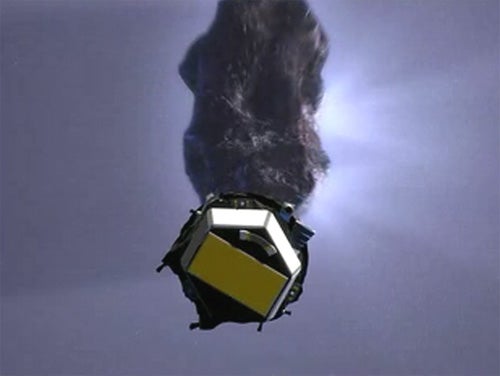On July 4, an 800-pound copper projectile released from NASA’s Deep Impact space probe will strike Comet 9P/Tempel 1 at 23,000 mph. Ideas abound as to how big a crater will form and how much material will be ejected. But the most interesting question, especially for amateur astronomers, is “How much will we be able to see?”
Observations of the comet have been ongoing. Ground-based telescopes show a dark, oblong object with a width of a couple miles. Spitzer and Hubble refined these measurements, revealing a deep-black comet that reflects only 4 percent of the light that falls on it. Tempel 1 measures about 8.7 by 2.5 miles (14 by 4 kilometers) across.
“Even tiny adjustments to our model of Tempel 1 are crucial to hitting the target and setting camera exposure times,” said Carey Lisse of Johns Hopkins University, Baltimore. “Like photographers, it’s important for us to know our subject before the shoot.”
Tempel 1’s shape and rotation rate (about 2 days) were derived from long-term observations made by various telescopes, including Hubble, Spitzer, and the University of Hawaii’s 2.2-meter telescope at Mauna Kea.
And speaking of Hawaii, for the first time ever, the W. M. Keck Observatory will let visitors “eavesdrop” on actual observations as they come in from Deep Impact. The event, which will provide a rare opportunity for the public to share in the thrill of discovery, takes place at Keck Observatory Headquarters on Hawaii Island from 7 to 10 P.M. Sunday, July 3, 2005. Impact is expected at 7:52 P.M. Hawaii Time.
Live images will be broadcast to a large display screen at Keck Headquarters, and a remote-control link to the Keck II control room will let people observe real-time action during the event. On-screen displays from the observing rooms will let the public see what the astronomers see.
“We are very excited about our participation in this unique astronomical event,” says Frederic Chaffee, director of the W. M. Keck Observatory. “All the major telescopes on Mauna Kea are working together to be certain that we use the best capabilities of each facility. The data we obtain will be made publicly available as soon after the event as possible so that astronomers all over the world can begin to digest and interpret the results.”
One telescope on Mauna Kea will have a unique view. The Submillimeter Array (SMA) studies millimeter and submillimeter radiation with wavelength ranges from 0.3 to 1.7 millimeters, (0.01 to 0.07 inch).
“The SMA will be the only operational millimeter or submillimeter array observing Tempel 1 at the time of the impact” says astronomer Charlie Qi of the Harvard-Smithsonian Center for Astrophysics (CfA). “As such, there’s no telling what we may see!”
By observing submillimeter radiation, the SMA can “fingerprint” Tempel 1 and determine its molecular composition. “SMA will observe mostly cool gas and dust with relative chemical abundances that may or may not be typical of other comets. We hope to see something not typical, because that would be most exciting to us scientifically,” says Qi.
Of course, observations will take place outside the United States. The European Space Agency (ESA) will participate in the post-impact observations from Chile. As soon as Tempel 1 is visible after the impact, and for a whole week thereafter, all major ESA telescopes will be observing Tempel 1.
To allow journalists to share these unique moments, ESA’s media center will open its door July 4 and 5. Live links will be maintained with two ESA observatories in Chile — La Silla and Paranal — as well as with the ESA/ESTEC (Netherlands) control center.










